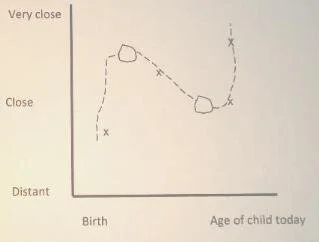4. Our child's development exercise
This exercise was developed by Andrew King in the first psychoeducational group work fathering program to be published in Australia - that was called Facing the Challenge - Fathering Today (1998 and published by the NSW Family Support Association). This exercise was a special start to the first session of each group that enabled men to visually demonstrate the significance of their relationship to one of their children and how that relationship changes over time. It also highlights when men are more likely to struggle with insight into their children's needs as they are more likely to see their relationship with their child as always being the same constant level, rather than having a tidal effect of periods of closeness and distance.
Context: This exercise is excellent for connecting parents to their child’s significant developmental milestones and how close they felt in that relationship.
The exercise identifies two important things about child development:
Different ages when significant events occur
Emotional closeness to children varies due to significant events.
When to use: This exercise is valuable for mothers, fathers or other care givers to complete. It is useful when parents have periodic contact with their children (i.e. they are separated or their children are in care).
Conducting the exercise: Ask each participant to choose one of their children and write their child’s name in the top right hand corner. This exercise can be done without participants needing to write words but by using symbols instead. Explain that the horizontal line represents the child's age. On the right hand side of the page, the child's current age is written on the dotted line. Have everyone mark the horizontal age line in five different places representing 5 important events in that child's life which they remember. Explain that the vertical line represents how close or far away the father feels to that child at the five significant ages that they have marked.
Everyone circles on their sheet:
The age where the child changed the most physically
The age where the child showed their greatest independence
The age where that child was the hardest to get on with
Participants are asked to discuss their sheet and what did they learn from this exercise. If in a group, other people may also comment on the patterns they see.
An example of a sheet Name of child
Extension questions:
What did your child need most from you over this time?
How did you handle the periods of closeness and distance between you and your child?
Who did you learn this life skill from? How did they teach you?
How did you respond to your child’s developmental changes (need for independence and emotional difficulties)?

